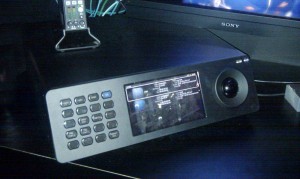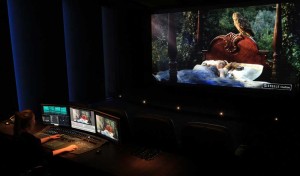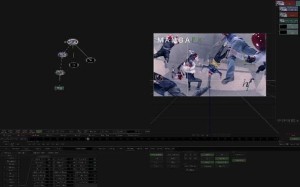Drawing a line between production and postproduction, as I’ve tried to do for our IBC coverage this year, involves a grey area that’s increasing in width every year. Much as postproduction as a discipline is more and more relegated to commodity computer hardware, cameras are also becoming computers, and delegating to post much of what might previously have happened in the back of the camera or the processing laboratory.
Key among these new requirements is the need to provide a monitor image that at least approximates the director of photography’s intentions for the final image. While it’s been possible to kludge something together to achieve this for quite a while, Filmlight was probably among the first to make a product out of it with its Truelight On-Set system a few years ago. It’s since been refined to create Filmlight’s FLIP device, a portable system with live grading as well as recording capability, refreshed at IBC this year with a new physical layout and new features. Alongside this, and potentially applicable to the same workflow, is the Baselight plugin for Avid on Windows, complementing the existing Final Cut and Nuke implementations. With these devices, approximate color correction decisions made early in the process can be carried through all the way from set via the edit to the final grade.

In a broadcast context, Blackmagic has also updated its ATEM 1 M/E switcher with 6-gibabit SDI ports for 4K (well, okay, quad HD) compatibility. This is important: while a lot of people at the show were keen to talk up 4K television, the better to sell everyone another new TV, precious few people were shipping or even announcing products. About the only company currently capable of putting together a 4K television studio is Blackmagic, if you’re willing to consider the Production Camera 4K for studio work.
Hey, don’t knock it: the viewfinder’s in the right place.


Any why might they want to do that? Well, it’s been difficult to ignore the elephant in the corner, which is that since NAB, Adobe has moved Creative Suite to a rental model. For any user other than someone who routinely bought each and every version of Creative Suite, it’s difficult to see this as anything other than a stiff price increase, and there has been considerable backlash. The importance of Photoshop, After Effects and Premiere to various industries can hardly be overstated, so this stuff matters.
To put it into numbers, the best I can find at the time of writing is that Adobe has about 12 million users of both the creative suite and individual products from it, about one and a quarter million of which it expects to have converted to rental users by the end of 2013. What we don’t know is how many of those people feel rather strong-armed by the situation. Adobe reps’ response, when I spoke to them, was to suggest that the new system was cheaper (it just barely is, considered against the purchase of each and every upgrade, forever) and that it would allow them to push out more frequent updates. Confronted with the hardly-controversial fact that they could have chosen to do this anyway, reference was made to a complex provision of publicly-floated company law regarding revenue reporting which would have prevented it. Regardless of whether you find that convincing (Microsoft pushed new features in Windows service packs, after all), one of the biggest problems with the new model is that it gives Adobe no incentive to work on the software. We must wait and see what actually makes its way into new versions of what was Creative Suite, but this situation stirs memories of what happened in the print industry with swingeing price increases by QuarkXPress and its eventual de-facto replacement with PageMaker, which was of course built by – with searing irony – Adobe.
And while I’m on this rather daring interlude, Avid springs to mind. That quip I made earlier about stagnation in the old guard of postproduction springs back to life here, although Lightworks is just as ancient and seems reinvigorated under Editshare‘s ownership with the Linux version imminent and Mac compatibility expected to hit alpha at the end of the year. At IBC, improvements to multi-camera workflows and support for AJA I/O devices, among other things, were shown.
Avid seem less eager to make big changes to its software, perhaps because its popularity is linked closely to usability and the habituation of all the world’s editors to the way Media Composer behaves. Avid announced a new audio mixing control surface and an expansion to its already prodigious range of shared storage equipment but otherwise seemed most eager to talk about the positive public response to its NAB announcements.

To rush through a few things of niche but still significant importance, it’s only fair to mention the sheer technical achievement of Digital Vision and its Thor hardware, designed to implement the company’s noise, grain and dirt cleanup algorithms on 4K and, soon, even 8K material in real time. While it’s easy to be critical of automated cleanup tools, they’re often the only solution to material that lacks the sort of value where the absurdly labor-intensive process of frame-by-frame manual intervention is practical. To get extremely nerdy, the Thor hardware comprises a PCIe card with two absolutely enormous FPGAs on a twenty-layer PCB, the manufacturing process for which is doubtless a feat in itself.
And finally, let’s talk about that which was once the core of the world as far as high end post went: yes, people are still selling film scanners. Filmlight reported that it is still shipping Northlights, albeit quite often as a custom job with user-specific features, and Lasergraphics report good results from its ScanStation high-speed scanner. This is likely to remain a relevant area for decades to come, since even if nobody ever shoots film again – which is unlikely – there’s the best part of a century of popular culture locked up in negatives and prints all over the world. With the likes of Spirit becoming dated and expensive to support, it seems that people currently involved in the high-value engineering requires to support photochemical film need be in no fear of their jobs.
Post at the moment is a mixed bag of things that can’t be moved to commodity hardware, like film scanning; things that are in the process of being moved, like high-resolution grading, and things that have long since been computer programs. Where a chunk of someone’s workflow can be made into a bit of software and thrown on a computer, it is of course easier to bundle it up in a rack case and take it on set, which brings us back to our initial thoughts about the migration of post into an on- or near-set position. If change in this area can be said to be progress, IBC2013 represented the usual amount of progress. What I’ll remember about it, though, is Adobe’s unexpectedly early foray into software rental, about which we’ll have to wait to learn more.






